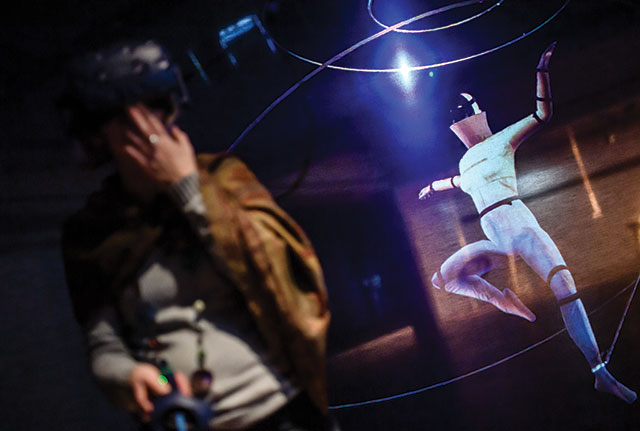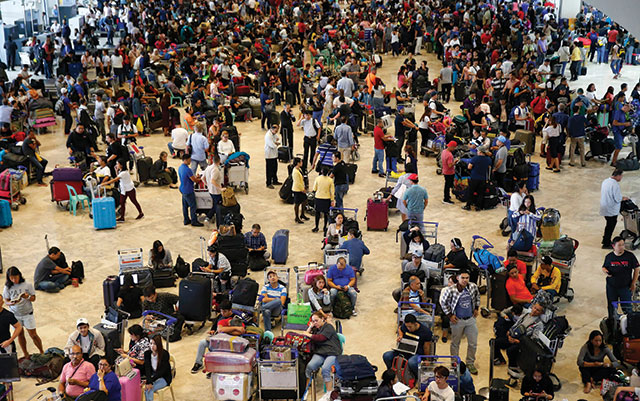We know what has already happened, say, in the past decade – or at least we think we do. What’s coming in the future – the next decade, for example – we obviously can’t know. But to make best guesses is human nature, not to mention the underpinnings of corporate management and the consultancy industry. How we make those best guesses, though, is fraught with uncertainty. Armed with data and experience of the past, we tend to extrapolate and typically describe a future that – comfortingly – is very much like the past.
This presents two big problems. Firstly, our memories are short; extrapolation from the recent past provides much confidence only for the very near future. And a decade is a long time. Secondly, the future is not like the past because it is filtered through the present, which is another aeon altogether. The present is shaped by forces that, because we are living much too close to them, we cannot hope to understand with any long-term perspective.
So, to try to describe aerospace and aviation a decade hence and beyond, it may be useful to consider the implications of four trends. All are big enough to be “megatrends” and, if we look back 10 or certainly 20 years, they probably even qualify as revolutionary: digitalisation, geopolitical upheaval, climate change and generational change.
Digitalisation refers to the impact of information technology on most aspects of our lives, from communications to data exploitation, to security. As for geopolitical upheaval, the end of the Cold War birthed the globalised world we have known seemingly forever but which dates back barely 20 years; today, that unitary, US-dominated world order appears to be splintering into regional blocs, if not into outright disorder.
Climate change threatens – legitimately, according to all the science – the very habitability of our planet. Generational change happens every generation, but there is cause to think the so-called millennials, born from the early 1980s to the early 2000s, are different – if, for no other reason than they are the first generation of digital natives and do not much remember a time when we were not existentially fearful of geopolitical and climate chaos.
We asked several experts to scan the future along these trend lines and wonder, how can aerospace respond?
INTERTWINED RELATIONSHIPS
Professor John Louth, defence, industries and security programme director at the Royal United Services Institute in London, addresses the impact of digitalisation with a question: today, do we think of an aircraft as an iPhone (disposable) or a washer-dryer (durable goods)? To consider this question is to realise that the four megatrends looked at here are closely related.
Civil and military aircraft have, in the decades since the Second World War, been developed in tandem but, notes Louth, that is less and less true today. Military aircraft are very expensive and built in small numbers – we no longer tolerate losses and the traditional fighter is an out-of-date concept. So, again, consider the iPhone versus washer-dryer question. What does a fighter look like? How much does it cost? How is it used, what is its lifespan, is it disposable?
For civil aircraft, he says, the big issue today is the fact that we are not excited about getting on an aircraft anymore. Louth is convinced that technology will reduce the need – and demand – to fly. Virtual reality (VR) and simulators will, increasingly, feel real. This is leading us to reorganise our companies and our personal lives around a notion of “lateralism” – a situation where competing interests of equal power negotiate with each other for time, energy and resources.
He points to virtual reality and observes that its use is not just a technology question, it is also a personal matter. To shake hands is sometimes needed – but in a world where 15-year-olds are boycotting school to fight climate change, it is clear that a growing number of coming-of-age citizens believe that it is wrong to consume the world’s resources.
Ultimately, the impact of Louth’s line of reasoning can perhaps be well appreciated in the context of that classic business school case study, the post-war decline of the US rail industry. Rail barons saw themselves as being in the railway business and so failed to recognise that they were really in the transportation business. As a result, they were outflanked by road and then air transport, which offered greater flexibility, sometimes greater speed, and was heavily supported by US government infrastructure investment.
Louth asks if the huge leap in the capability of digital technology, and our relationship with it, prompts the question: is our concept of “aerospace” outdated?
Certainly, much has changed. In military terms, says Louth, in the past if we imagined the mission of destroying a city we thought in terms of a fleet of strategic bombers. Today, all that is needed is a team of hackers.
And airlines? If they are in the business of transporting goods or freight, he says, they need to recognise that, today, we ship very few heavy components; manufacturing has gone local, so what we ship are technology licences.
A similar narrative may, in Louth’s reasoning, play out in leisure travel. Millennials – digital natives – are comfortable with VR for both meetings and for pleasure. Indeed, Louth is confident that much holiday/leisure travel will come to be replaced by stay-local VR experiences.

Is VR is the new reality?
Clemens Bilan/EPA-EFE/REX/Shutterstock
NEW CONSUMERS
It is not just school-boycotting teenagers like Sweden’s Greta Thunberg who are demanding action on climate change and turning away from consumption. Consider the “No Fly Climate Sci” group of Earth scientists, academics and members of the public “who either don’t fly or who fly less”. As their website declares: “Academics are expected to attend conferences, workshops, and meetings. Many academics, including Earth scientists, have large climate footprints dominated by flying. Meanwhile, colleges and universities ostensibly exist to make a better future, especially for young people. We want our institutions to live up to that promise.
“We’re experimenting with having successful and satisfying lives and careers without all the flying.”
So, says Louth, in the future we will need a strong business case to travel – it will not be good enough to simply explain why you are not comfortable with the VR technology. And, he says, there is no question that “the technology will get better and better and better”.
Another take on the question of how climate change might transform public attitudes towards aviation comes from Chris Bullick, managing director of the Pull Agency, a branding and marketing firm based in Surrey, the UK. He quotes Douglas Coupland’s 1991 novel Generation X, which gave a name to the generation that bridged the baby-boomers and millennials: “Use jets while you still can.”
Says Bullick: “This always struck me as the ambivalent way that we view air travel. It seems fortuitous for the aviation industry that society might have reached peak environmental hypocrisy, to the point where a Hollywood celebrity can really seem to miss the irony in flying to pick up an environmental award on a private jet – Leonardo DiCaprio flew an 8,000-mile round trip from Cannes to New York to pick up an award.
“But really, are the travel hungry masses any better?”
Bullick wonders: “To what degree will the aviation industry come under question from the real world, from consumers and not committees and activists? And what should they do about it?”
Both Airbus and Boeing, he says, have on the one hand been at pains to promote the environmental credentials of their latest aircraft: “But unsurprisingly, the message is a bit mixed, with fuel efficiency the most promoted aspect of their narrative. It’s always going to be a tough gig to push the green credentials of something designed to gulp about a gallon of hydrocarbon fuel a second.
“It’s clear to me – an aviation lay person – that the latest generation of aircraft are lighter and more fuel efficient, and for what it’s worth, I have been on the receiving end of much more messaging along those lines from Boeing than Airbus. Boeing seem to be investing more in promoting the improving credentials of their aircraft, to the point that they seem to own ‘lightness’ as a brand.”
As a brand strategist, Bullick’s advice to airlines and aircraft makers is to recognise that “green washing” the aviation industry will not work. “For us, brand positioning is really about bringing forward core positive truths about client brands. To be fair, that is what the aviation industry is probably doing, while of course not bringing forward the negative ones. But could aviation-related brands do more?
“I think they could. Our advice is always that authenticity is key. Essentially, if you can’t say something good about your role in society, don’t make something up. If you could do more – do it. For me, that means owning up to the issue and doing something about changing things. It might even be in your long-term interest.”

School? That’s for people with a world to live in
SECURITY
Nobody in aviation can ignore one of the obvious clear and present dangers linked to digitalisation: cybersecurity. British Airways and Cathay Pacific are just two recent victims of major hacking operations that compromised millions of passengers’ personal data; they were neither the first nor last to suffer such a breach.
Pete Cooper is a former UK Royal Air Force Tornado pilot and instructor who went on to advise the Ministry of Defence and international organisations on cyber operations and security and last year wrote a report on the subject for the Atlantic Council think tank. He is clear that digitalisation is providing great benefits to aviation: efficiency, passenger satisfaction and better information to managers and pilots. But it is also creating “exponential” growth in the number of weak points – cyber experts call them “attack surfaces” – and the aviation industry, he says, has yet to form a comprehensive, coherent answer to managing these risks.
Adversaries, he believes, are putting lots of effort into compromising aviation IT systems but, he says: “With effort, we can head off risks”; aviation is accustomed to dealing with failure, through back-up systems and training.
The first generation of cyber attacks are mostly aimed at denial of service. If aviation sees its communications disrupted, it should be able to get around that thanks to back-up systems. But, warns Cooper, a second generation of attacks will probably target the integrity of data – leading to wrong, even catastrophically wrong, operational decisions and, critically, undermining confidence in the information fed to, say, pilots and air traffic controllers.
Here, he says, the industry must be diligent. Digitalisation unifies systems and communications and can simply attack surfaces by creating what Cooper calls an “IT monoculture”. An example of such a weakness occurred in December, when millions of data accounts were blacked out in networks used by O2 and other operators across the UK and several European countries, owing to what appears to have been a single certificate going out of date in commonly used third-party software.
Another obvious example of a risk is posed by increasing reliance on satellite navigation. The GPS, Galileo and Glonass systems underpin innumerable services – which would fail with the loss of those inputs.
But what to do? Cooper’s advice is to maintain international consistency – diverse security standards will increase complexity and cost, and introduce weaknesses. Pay attention to the basics: design systems for resilience; have enough people in place to identify and patch problems; and ensure contracts and management are configured to sustain reliable, secure services.
And, he says, it needs to be standard practice to share information so partners and anyone reliant on the system can learn quickly from the first attacks – that is, to take a global approach to managing the security of critical systems.
Ultimately, there is no effective security without understanding the adversaries and their objectives. But this basic foundation of good security is more easily stated than realised. One known and persistent threat to aviation comes, of course, from terrorists. And, one thing we know about terrorists, says Cooper, is that they evolve their methods based on their objectives, opportunities and capabilities.
Aviation may also be threatened by actors whose motive is money or even political aims. Attackers may seek – for whatever reason – to cause disruption, rather than death, injury, destruction of physical property or financial profit. In such cases, are the attackers state, quasi-state or purely private actors?
And, if the problem does not look complex enough, Cooper reminds everybody not to be surprised if attacks – however motivated – have multiple repercussions. So much is dependent on aviation that disruption could kick off a cascade of impacts felt globally.
Critically, he stresses, industry leaders must push for widespread recognition of the problem and global action. Fortunately, he sees aviation as being well placed to cope with a fluid cyber future. Organisations like IATA, ICAO, EASA and the Airports Council International, says Cooper, are in a strong position to guide the development of a resilient aviation sector.

Beware online friends
Seth Wenig/AP/REX/Shutterstock
GEOPOLITICS
Is the globalised world being transformed – or returned – to a world of regional blocs: the Americas; Europe, the Middle East and Africa and the Asia-Pacific region? Louth sees a flaw in the strategic investment mindset of the late 1990s and early 2000s, which assumed the triumph of Western values and a globalised world: “We forgot to think of the way states organise themselves, based on some sort of competition,” he points out. When the Berlin Wall fell, “I think people made incorrect strategic calls.”
The issue today is, if the world is not as ordered as we thought – if both the bipolar Cold War order and the subsequent unified global order have both been swept aside – we need to think about what concept organises the world today. And, says Louth, the fact is no-one knows anymore.
So, the big question for the aerospace industry becomes how can we think strategically? What is our long-term strategic direction? This is the great challenge; a company director’s tenure may be just three to five years, and business schools today teach tactics, rather than strategic purpose. That is, says Louth, even business has no long-term purpose. And, without a purpose, it is difficult or impossible to protect yourself from disruptions.
The complexity of the world today is beyond what humans can manage. Louth considers the example of a Spitfire – it had 70 components and you could understand it. But a modern fast jet has a far greater number of pieces and you cannot understand it.
“An aircraft now is a totality of licences and permissions. It’s software, not metal,” says Louth.

Simpler times
Felipe Trueba/EPA-EFE/REX/Shutterstock
FINANCIAL STRAITS
The combination of a geopolitical upheaval and the ongoing financial fragility of governments puts aerospace and defence firms in a bind. Scott Thompson, US national leader for the aerospace and defence practice at consultancy PwC, notes that the US Department of Defence (DoD), which is in this regard no different from its counterparts in Europe, is strapped for cash. And what may be a permanent spending squeeze will strain, or even break, the traditional model whereby government sets the requirements for a new aircraft or weapons system and industry responds.
Thompson thinks companies are going to have to be more willing to spend substantial sums to realise their own visions of the future. This is not unprecedented – General Atomics and its development of drone technology is an example – but it places a huge financial risk on companies. If a cash-poor DoD wants to hold to the traditional cost-plus-10% payment model, the system could break down. Aerospace and defence companies, says Thompson, are not profitable enough to take on large development projects if the government is not taking the financial risk.
Meanwhile, a shifting geopolitical landscape is raising the temperature. Defence analysts are increasingly warning that the USA’s technological advantage is eroding – and entertaining the notion that it could well lose a conventional war against China or Russia. Thompson sees these potential adversaries as “very, very, very strategic in terms of how they approach defence”. Hypersonic technology, cyber warfare and artificial intelligence are high on the development list, and the USA needs to respond accordingly – which means US defence firms need to target their investments, internal research and acquisitions at technologies that can make the difference.
Unfortunately, technologies like artificial intellience are expensive to develop and pose a high risk of failure. In short, how to pay for it is as big a conundrum as what to aim for.
OVER TO YOU, MILLENNIALS
In all of this, Thompson sees a significant role for the millennial generation – if aerospace companies can adapt to them. Thompson reckons major firms are taking a proactive stance in reaching out to millennials in a bid to bring digital skills into their workforces. Companies need these digital natives if they are going to realise a digital transformation of their businesses – and, of course, they need to motivate them to stay with them.
There is thus some urgency to this recruitment and retention quandary. Millennials are badly needed and they are also sought after by the technology industry. Thompson warns that while aerospace and defence jobs – and vacancies – are plentiful in the Washington DC area, companies are no longer advantaged by the simple fact that the technology industry has traditionally been in California. Now, big technology firms such as Amazon are opening East Coast headquarters and will soon be recruiting tens of thousands of young people.
Another factor that aerospace and defence firms have to reckon with is that those millennials they do hire will move relatively quickly into management roles, says Thompson. That is because post-Cold War cutbacks have left the aerospace and defence industry with a “missing generation” to fill.
So, bearing in mind that aerospace companies are staid and traditional compared with the technology industry, the question today is, perhaps: does the company shape the worker or does the worker shape the company?
WHAT TO DO?
Bullick sees both a huge challenge and a huge opportunity – and one that may play out relatively well for aviation. “The big automotive brands see their biggest threat as the industry being turned upside down by autonomous cars from the likes of Google and Apple. In the automotive world, those brands have nothing to lose and everything to gain. The same would be true of a true disrupter in aviation.
“Clearly, replacement energy systems required to fly hundreds of people at 500mph aren’t going to be developed any time soon. But perhaps an appetite to have air travel redefined could be turned to the industry’s advantage. Consumers’ dissatisfaction with the process of flying seems to have grown in parallel with their appetite for doing it.”
Bullick asks if consumers might “trade the incredible convenience of semi-circumnavigating the planet in a day for something more sedate, and much more enjoyable”. Hardened aviation industry bosses may see little prospect of his vision of “an ionic wind-powered super-galleon that takes three days to cross the Atlantic but does it in style and comfort” winning over hassled but cost-conscious budget travellers – however much traction might be found with the first- and business-class crowd.
But his conclusion offers much food for thought: “Aviation brands that admit the problem and can demonstrate real endeavour to clean up the act of flying will win support. And the world’s giant aviation brands have it easy compared with their automotive counterparts.
“At the end of the day the barriers to compete with Airbus and Boeing are still much more formidable than those to compete with Audi or Ford.”

Next time, maybe just stay home…
Bullit Marquez/AP/REX/Shutterstock
Source: Flight International













